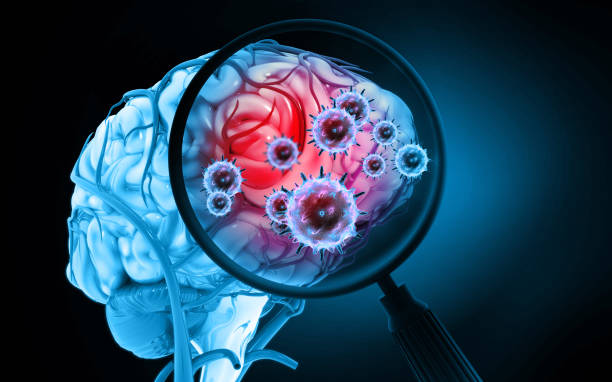
Encephalitis is inflammation of the brain and a serious condition that requires prompt treatment to lower the risk of lasting complications or death. The inflammation of the brain’s active tissues results from an infection or an autoimmune response and causes the brain to swell, leading to headaches, stiff neck, sensitivity to light, mental confusion, and seizures.
Encephalitis strikes 10–15 people per 100,000 each year and can affect anyone, but more often occurs in younger people.
What causes encephalitis?
Though the exact cause of encephalitis is often unknown, autoimmune inflammation, viral and bacterial infections, and non-infectious inflammatory conditions all can cause encephalitis.
Cases of encephalitis are likely to continue to rise as more and more autoimmune causes are recognized. Infections such as Zika, chikungunya,Powassan viruses, and Japanese encephalitis viruses can also contribute to this trend.
Symptoms of encephalitis
Encephalitis sometimes starts off with flu-like symptoms, like high temperature and headache.More serious symptoms come on over hours, days, or weeks, including:
- confusion or disorientation
- seizures or fits
- changes in personality and behaviour
- difficulty speaking
- weakness or loss of movement in some parts of the body
- loss of consciousness
Types of encephalitis
There are two main types of encephalitis:
-
Primary or Infectious Encephalitis
This condition occurs when a virus or other agent directly infects the brain. Vaccines for measles, mumps, rubella, and chickenpox have reduced the rate of encephalitis from these diseases, but other viruses such as herpes simplex virus type 1 and 2, varicella-zoster virus, and enteroviruses, which cause gastrointestinal illnesscan cause encephalitis.
Primary infection may be a reactivation of an inactive virus after a previous illness.Encephalitis can also result from certain viruses carried by mosquitoes, ticks, and other insects or animals.
-
Secondary or Autoimmune Encephalitis
This condition results from a faulty immune system reaction where the immune system mistakenly attacks healthy cells in the braininstead of attacking only the cells causing the infection.Secondary encephalitis often occurs 2 to 3 weeks after the initial infection. The causes of autoimmune encephalitis are often not well understood, but it can sometimes result from a tumour (benign or cancerous). Some types of autoimmune encephalitis such as acute disseminated encephalomyelitis (ADEM) are typically triggered by an infection (post-infectious encephalitis).
Encephalitis Panel Test
The encephalitis panel test is used to rapidly detect a panel of common viruses, bacteria, and fungi associated with encephalitis. But this test cannot be used as a replacement for CSF bacterial and/or fungal culture and Cryptococcal antigen testing for at-risk patients. And a negative result does not exclude a diagnosis of meningitis or encephalitis due to infection.
This panel includes Cryptococcus neoformans/gattii, Cytomegalovirus (CMV), Enterovirus, Escherichia coli K1, Haemophilus influenza, Herpes simplex virus 1(HSV-1), Herpes simplex virus 2(HSV-2), Human herpesvirus 6 (HHV-6), Human parechovirus, Listeria monocytogenes, Neisseria meningitides, Streptococcus agalactiae, Streptococcus pneumoniae, Varicella-zoster virus (VZV).
Autoimmune Encephalitis Panel Test
The test is used in patients for the diagnosis and differential diagnosis of autoimmune encephalitis who show symptoms of neurological and behavioural conditions. This test detects the antibodies against different neurological receptors.
NMDA: Antibodies against glutamate receptor (type NMDA - NR1) are specific markers for anti-glutamate receptor (type NMDA) encephalitis, an inflammatory encephalopathy autoimmune disease.
AMPA: This test is done if a patient has partial onset seizures or generalized tonic-clonic seizures. GABA receptor: These receptors are responsible for signal transmission and associated auto immunities manifest with seizures and neuropsychiatric symptoms.
VGKC [LGI1]: LGI1 antibodies test help in the diagnosis of autoimmune limbic encephalitis.
Autoimmune encephalitis panel includes 4 tests to detect the presence or absence of antibodies against NMDA receptors, AMPA (GluR1 & GluR2), GABA B receptor, and VGKC (LGI1, ASPR2)
Detection of auto-Abs is the best diagnostic method for autoimmune encephalitis and because an early application of immunotherapy is essential for the treatment of autoimmune encephalitis, early suspicion based on clinical findings is important.
The laboratory diagnosis of autoimmune encephalitis consists of the detection of auto-Abs, EEG, MRI, functional neuroimaging, and work-up for systemic tumours.Although about half of all autoimmune encephalitis series are Ab-negative cases, the detection of auto-Abs is a confirmatory diagnostic test. Three basic research techniques are used for this purpose: tissue-based assay, cell-based assay, and immunoprecipitation.
Indirect immunofluorescence or secondary immunofluorescence helps to detect circulating autoantibodies in patient serum. It is used to diagnose autoimmune blistering diseases.
To Conclude
Encephalitis is an uncommon but serious condition in which the brain becomes inflamed or swollen.It can be life-threateningcalling for urgent treatment in a hospital.Anyone can be affected, but the very young and very old are most at risk.It's not always possible to prevent encephalitis, but some of the infections that cause it can be prevented with vaccinations.

